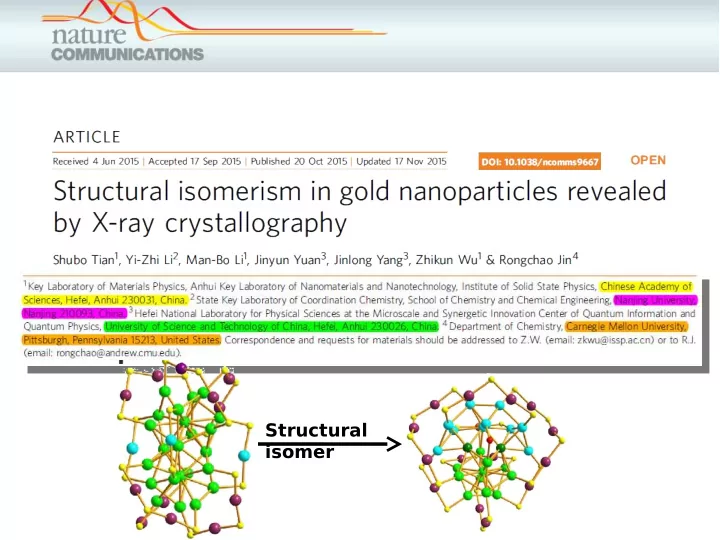

Structural isomer
Background….
Structural isomerism • Structural isomerism at nanoscale. • Resolving structure reveals structure property correlation and guidance for synthesizing functional material. • Au 24 (SCH2Ph-tBu) 20 and Au 24 (SePh) 20 have difgerent Au24 core structures. Synthesis of PTLC, ESI-MS, Single crystal X- Au 38 PET 24 TGA, XPS Ray crystallography(S 50°C CXC) Au 38Q (old)- Au 38T (new)- Qian Tian
(a) ESI mass spectrum of the Au 38T . (b) TGA of Au 38T .
(c) XPS spectrum of Au 38T . (d) Ultraviolet–visible–near-infrared absorption spectra of Au 38T (blue) and Au 38Q (black) in toluene (measurement temperature: 0° C). Insets are the photo of thin- layer chromatography and enlarged absorption spectra in the range from 800 to 1,200nm of Au 38T and Au 38Q .
Au 38Q (old) 6Au 2 S R 3 3AuSR 2 Au 38T (new) 180° rotation
Comparison of ultraviolet–visible–near-infrared absorption spectra of Au38T . Blue: experimental; black: calculated by time-dependent density function (TDDFT) method. Inset is the enlarged spectra in the range from 800 to 1,200 nm.
(a) Time-dependent ultraviolet–visible–near-infrared absorption spectra of Au 38T at -10°C in toluene. (b) Ultraviolet–visible–near- infrared absorption spectral transformation at 50°C in toluene (the isosbestic points are at 360 and 700 nm). Inset: thin-layer chromatography of Au 38T before and after the transformation. (c) ESI mass spectrum of the transformed product.
Conclusion • A novel synthesis method is developed, with which a novel gold nanoparticle is readily synthesized, and the composition of the as-prepared nanoparticleis precisely determined using ESI–MS in conjunction with XPS and TGA. • The structure of Au38T is resolved using SCXC and the unique structural features provide important implications for nanocluster structural studies. • Signifjcantly, structural isomerism is observed in nanoparticles for the fjrst time. • The distinctly difgerent properties (in particular the catalytic properties) of the two structural isomers indicate a structure–property correlation and this will have important implications for future catalytic studies.
F uture directions. HPLC separation of clusters is a very new fjeld. Finding suitable eluents and column for ligand exchanged products, chiral mixtures and other isomers will lead to effjcient separation.
THANK YOU
Recommend
More recommend